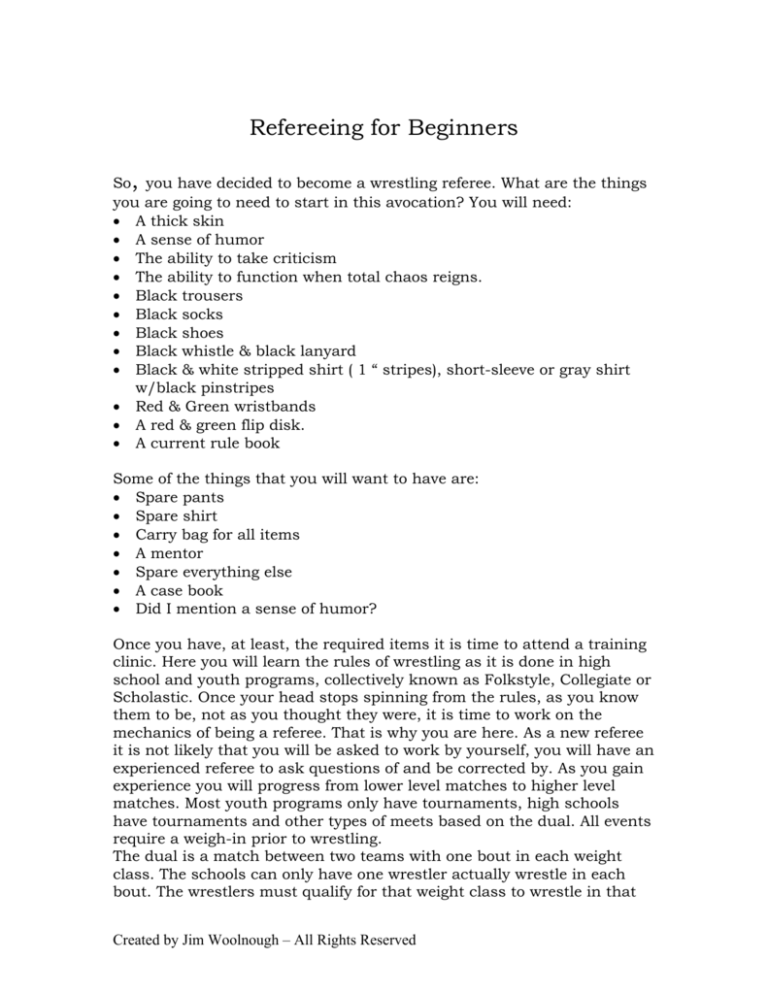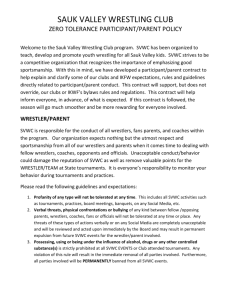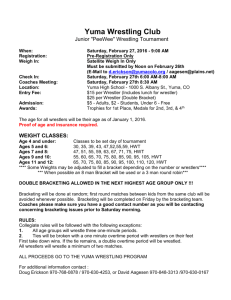
Refereeing for Beginners
So, you have decided to become a wrestling referee. What are the things
you are going to need to start in this avocation? You will need:
• A thick skin
• A sense of humor
• The ability to take criticism
• The ability to function when total chaos reigns.
• Black trousers
• Black socks
• Black shoes
• Black whistle & black lanyard
• Black & white stripped shirt ( 1 “ stripes), short-sleeve or gray shirt
w/black pinstripes
• Red & Green wristbands
• A red & green flip disk.
• A current rule book
Some of the things that you will want to have are:
• Spare pants
• Spare shirt
• Carry bag for all items
• A mentor
• Spare everything else
• A case book
• Did I mention a sense of humor?
Once you have, at least, the required items it is time to attend a training
clinic. Here you will learn the rules of wrestling as it is done in high
school and youth programs, collectively known as Folkstyle, Collegiate or
Scholastic. Once your head stops spinning from the rules, as you know
them to be, not as you thought they were, it is time to work on the
mechanics of being a referee. That is why you are here. As a new referee
it is not likely that you will be asked to work by yourself, you will have an
experienced referee to ask questions of and be corrected by. As you gain
experience you will progress from lower level matches to higher level
matches. Most youth programs only have tournaments, high schools
have tournaments and other types of meets based on the dual. All events
require a weigh-in prior to wrestling.
The dual is a match between two teams with one bout in each weight
class. The schools can only have one wrestler actually wrestle in each
bout. The wrestlers must qualify for that weight class to wrestle in that
Created by Jim Woolnough – All Rights Reserved
weight. If one school does not have a wrestler for a weight class, then
that match is forfeited by that school. A wrestler who receives a forfeit
can not wrestle in any other weight class. If neither school has a wrestler
for a weight class, then it is a double forfeit and neither school will earn
points for that match. Once all matches are wrestled, the team points
earned by each wrestler are totaled, subtracting team point penalties,
and the winning team is determined. If there is a tie between the teams,
follow the tie-breaking criteria listed in the rule book.
The various types of events based on the dual are:
• Tri’s – meets with three teams in attendance
• Quad’s – meets with four teams in attendance
• Multi-ways – meets with 5 or more teams in attendance
• Dual meet tournaments – meets where teams advance through
brackets based on win/loss of a dual
Individual tournaments are meets where the schools are represented by
one wrestler in each weight class. The wrestlers then progress through
the event based on win/loss of each bout.
In all cases you, as the new official, will report to the Head/Lead official
to find out what your assignment will be for the event. Do not leave the
event without notifying the Head/Lead official. The Head/Lead official is
there to administer the tournament and assist with your progress.
Now, are you ready to step out on the mat? Think so, well think again.
OK, lets’ do it.
The Match
Step out to the center of the mat. Make sure you are in proper and
complete uniform before doing so.
From there you will observe the wrestlers as they head to the score table
to check in for the match. Check them as they move towards the table to
see if they are properly dressed and equipped. If you spot an error, have
them fix it before they check in. If their errors are fixed prior to check-in,
you do not have to penalize them. Once they have checked-in then it will
be necessary to follow the penalty chart and assess penalties. Make a
mental note of which wrestler is which color; you will need to know this
later.
Have the wrestlers stand on their lines (neutral starting position) and
shake hands. When ready step back and blow your whistle, also give the
starting hand signal. Now observe the wrestlers carefully from a distance.
You want to be far enough away so that you can see everything they are
doing but close enough to stop them from violating the rules or hurting
each other. Basically you will want to be looking between them as they
face each other. When one of them makes a scoring attempt you will
need to change position so that you can observe the entire move and be
in the best spot when the attempt finishes.
Created by Jim Woolnough – All Rights Reserved
Once a takedown is secured move to the front (where the heads are) to
observe what is happening. Move from side to side to watch what is
happening away from the heads and make sure everything is a legal
hold.
Blow the whistle to stop the match when:
• They go out of bounds
• An illegal hold is applied
• Bleeding or injury
• You become concerned for safety (potentially dangerous hold)
• Both wrestlers need to be addressed
• A fall or tech fall occurs
• Time expires
• A coach requests a timeout to discuss a rule, when there is no
significant action
Restarts from out of bounds call for each wrestler to be placed where
they were when they went out of bounds, Offensive, defensive or neutral.
The offensive wrestler may inform the referee of his intent to have a
neutral start. Score an escape for the defensive wrestler and start the
match in neutral.
If the first period ends and you do not have a winner, move to the second
period. Give the choice of position to the correct wrestler and start the
period.
For duals, the correct wrestler will be decided by the pre-meet disk flip.
One team will have chosen odds and the other team is evens. That choice
determines who reports first for each match as well as who will have
choice in the second period. The team with the odd matches will have
choice in the 1st, 3rd, 5th, etc… All matches count as odd or even,
including forfeits. For tournaments you will flip the colored disk and the
color that shows will have choice. The choices available are, offensive
(top), defensive (down), neutral, or defer choice. Ask the correct wrestler
“Do you want to be up, down, neutral or defer?”. Try to position the
wrestler so that he is facing his coach when you ask for his choice. Once
the wrestler answers, that is the choice; coaches can not change the
choice nor can the wrestler. If the answer was “Defer” ask the other
wrestler “Do you want to be top, bottom or neutral?”. Place the wrestlers
in the correct positions and start the period. If the second period ends
without a winner then give the other wrestler choice and start the third
period. Develop a system to remind you who will have choice for the 3rd
period, flip disk, wrist band, etc… If there was no winner in the 3rd
period, place the wrestlers in the neutral starting position and start
Sudden Victory. The wrestler who scores first will be the winner. If the
score involves a takedown to the back then he is allowed to continue the
match to attempt to get a pin.
Created by Jim Woolnough – All Rights Reserved
If there is no winner from the Sudden Victory, then go to the tiebreakers. See the sheet on the Tiebreaker for 2007-08. At the end of the
match bring both wrestlers back to the center and have them shake
hands. Then raise the hand of the winning wrestler.
Stopping the match
If the wrestlers go out of bounds then blow the whistle and stop the
match. Have the wrestlers return to the center of the mat. Always keep at
least one wrestler in front of you on the way back to the center. This way
they can’t do anything you can’t see. Put them in the correct position and
restart the match.
If the offensive wrestler applies an illegal hold. Stop the match and watch
them closely as they get up. Do not let them do anything stupid at this
point.
Face the scorer’s table and signal the penalty and point(s) properly. If
you awarded points due to the illegal hold then correct the score and
continue the match. Place the wrestlers for the restart, as an out of
bounds, and restart the match.
If the defensive wrester applies an illegal hold, evaluate the situation. If
he is not on his back, stop the match and penalize as above. If the
defensive wrestler is in near-fall criteria and in danger of being pinned,
slow down and evaluate the situation closely. If there is no danger to the
offensive wrestler, allow the hold to continue. If the situation ends
without a pin, stop the match and award points as required. Rule 5-9-2i.
Stop the match when you observe bleeding from one or both of the
wrestlers. Award points as earned (5-9-2f, g, h) and start the blood time
clock for the wrestler involved. Make a note to yourself about the position
of the wrestlers when you stopped the match. Have the coach/medical
staff attend to the bleeding wrestler and go to the scorer’s table to
monitor and advise on blood time left.
Each wrestler has 5 minutes of blood time with no limit on the amount of
time-outs for bleeding. Once bleeding is stopped and treatment given,
stop the blood clock. Have the coach clean up any blood from his
wrestler that is on the mat. Restart the match as an out of bounds.
If one of the wrestlers is injured or indicates injury, stop the match.
Award points as earned (5-9-2f, g, h) and start the injury clock for that
wrestler. It is injury time if the wrestler is hurt by a legal move. Summon
the coach onto the mat to tend to his wrestler or allow the wrestler to go
to his coach. If needed, summon the competition medics. Go to the
Created by Jim Woolnough – All Rights Reserved
scorer’s table and monitor and advise on the injury time left. Injury time
is limited to 1 ½ minutes or 2 timeouts. Once either of those conditions
occur, there is no more injury time and the wrestler must either wrestle
or default. If this is the 2nd injury timeout for a wrestler, his opponent
will have choice of position for the restart.
If the wrestler was injured by an illegal move, he has 2 minutes of
recovery time. If he can not continue the match after using recovery time,
he will win.
If a hold moves to potentially dangerous and you become concerned for
the limb or joint, stop the match and restart it as an out of bounds.
If the match is degenerating into a stall fest or fistfight or other nonwrestling event, stop the match. Take both wrestlers to the center and
talk to them there. Leave no doubt about what you want to see happen,
wrestling.
If a fall or tech-fall happens stop the match. A fall is when the shoulders
or scapula of one wrestler are held to the mat for 2 seconds. The match
is over at this point. If a tech-fall (15-point difference) happens, stop the
match unless the defeated wrestler is on his back. In this case wrestling
continues to allow for the fall. Once the tech-fall happens the winning
wrestler can only lose by flagrant misconduct. No additional scoring can
happen.
If time has expired stop the match. Move on to the next period or declare
the winner as appropriate.
If a coach has requested a timeout to discuss a rule. Stop the match
when there is no action occurring. Discuss the situation with the coach.
If a change is needed, make the change. If not, tell the coach he is now
being penalized for misconduct (See Penalty Chart) and restart the match
as an out of bounds. If there was a change, restart the match as
appropriate.
Scoring
A wrestler scores when :
• He secures a takedown – gains control of his opponent down on the
mat. 2 points.
• He escapes – gains a neutral position after being controlled. 1 point.
• He reverses – gains control over his opponent either down on the mat
or from a rear-standing position. 2 points
• He holds his opponent in near-fall criteria for 2 second or more. 2
second = 2 points. 5 seconds = 3 points
Created by Jim Woolnough – All Rights Reserved
•
•
His opponent commits an illegal act – illegal hold, stalling, false start,
unsportsmanlike conduct, unnecessary roughness, etc… 1 or 2
points, see penalty chart.
He rides out his opponent in the tie-breaker- the top wrestler is
awarded 1 point for the ride out (RO) which is recorded on the bout
sheet.
The winning wrestler is the wrestler who:
• Has the most points
• Did not default
• Did not disqualify himself
• Did not forfeit
• Pinned his opponent
Ending the Match
When the match has ended take both wrestlers to the center of the mat.
Have the wrestler’s shake hands. Take hold of their hands with yours,
matching their colors to your wristbands. Raise the hand of the winning
wrestler. Release them and watch them to make sure they do nothing
that would be USC. They are not required to shake the other coach’s
hand.
Penalties
Penalties during a match are usually match points. A wrestler is
punished by giving his opponent points. A wrestler who commits 4
penalties is disqualified from the match and the match is over. The
opponent wins. If one of the wrestlers commits flagrant misconduct
during the match, the match is over and the opponent wins. Also 3 team
points will be deducted from the offending wrestlers’ team, all
advancement points will be erased and the wrestler removed from the
event and the premises.
Penalties that occur before or after a match will be team point penalties.
These will be flagrant misconduct and unsportsmanlike conduct.
Unsportsmanlike penalties are 1 team point for the 1st offense and 2
team points for the 2nd. UC penalties are attached to the individual
committing them and require removal for the 2nd UC penalty. UC
penalties carry over form day to day in an event. Flagrant misconduct
penalties are 3 team points and removal from the event and premises for
the duration of the event for the offender.
Coach Misconduct –
A coach who requests a timeout for a discussion and does not change the
referee’s mind will be penalized for misconduct. It is a warning for the 1st
Created by Jim Woolnough – All Rights Reserved
offense, 1 team point for the second offense, 2 team points for the 3rd
offense and removal from the premises for the day. Coach misconduct
penalties are charged to the head coach of a team and start fresh
everyday.
ALWAYS notify the Head/Lead official of all penalties to coaches. Make
notes on the bout sheet of penalties to coaches. Misconduct can only
occur at the scorer’s table during a conference between the coach and
the referee. If the coach interferes with the progress of the match from
anywhere else it is unsportsmanlike conduct and a team point penalty
(See Penalty Chart). A coach always has the right of approaching the
table to request a conference. A referee will always grant the request
when there is no action occurring.
Now that you have made it through your first match, repeat this between
80 and 150 times at your first tournament.
Things you can do to get better.
1. Read your rule book. Yes, again.
2. Read the case book.
3. Ask your mentor.
4. Watch video from the official’s point of view.
5. Attend your association meetings.
6. Visit officials’ forums on the internet.
7. Ask your mentor.
8. Read the rule book, yet again.
9. Attend events and observe other officials.
Created by Jim Woolnough – All Rights Reserved





